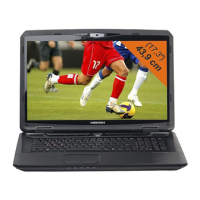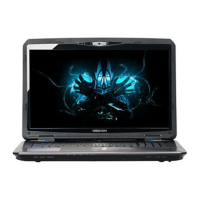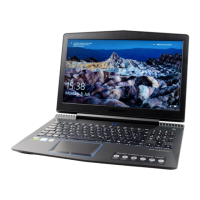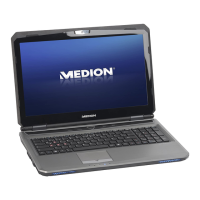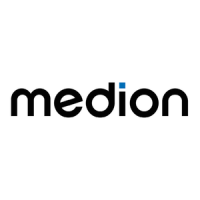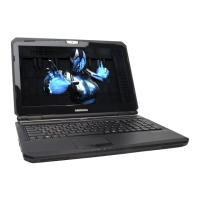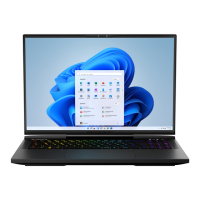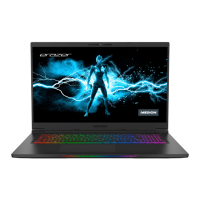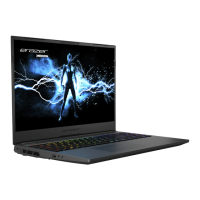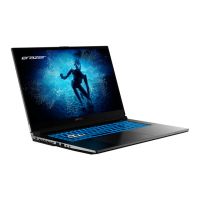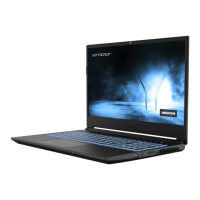Do you have a question about the Medion ERAZER X7833 and is the answer not in the manual?
Explains safety symbols and keywords used throughout the manual.
Defines the intended use and limitations of the notebook.
States compliance with European Union directives and regulations.
Warns about risks to vulnerable users and the importance of supervision.
Provides guidelines for safe operation, preventing damage, and avoiding hazards.
Advises against self-repair due to electrical shock and damage risks.
Recommends backing up data before updates to prevent loss.
Details ideal environmental conditions and placement for the notebook.
Specifies operating and storage temperature and humidity ranges.
Offers advice on optimal screen positioning to avoid eye strain and reflections.
Provides instructions for connecting the notebook and its power supply.
Details safe connection and use of the mains adapter.
Advises on proper cable management and peripheral connection safety.
Explains touchpad operation and care to prevent damage.
Warns about battery handling, replacement, and disposal.
Lists precautions to prevent display damage from stress or objects.
Identifies key components of the notebook when it is open.
Explains how to use the notebook's power button.
Details connecting and using the notebook with AC power.
Provides step-by-step instructions for initial notebook startup.
Explains the procedure for charging the notebook battery.
Advises on discharging the battery for optimal performance.
Discusses factors affecting battery life and relevant settings.
Shows how to check the current battery status via the taskbar.
Guides on adjusting power saving settings for battery optimization.
Explains the sleep mode function and its settings.
Offers advice on conserving energy and extending battery life.
Instructions on how to open and close the notebook display safely.
Details display resolution options and external monitor compatibility.
Describes mirroring the notebook display to an external monitor.
Explains extending the desktop across multiple monitors.
Details displaying output only on the main PC screen.
Details displaying output only on the external monitor.
Discusses notebook keyboard features and shortcuts.
Lists keyboard shortcuts for notebook functions.
Explains touchpad operation and settings.
Details two-finger gestures for touchpad control.
Lists and describes key system directories on the hard drive.
Provides safety precautions for using the external optical drive.
Specifies operating and storage temperature limits for the drive.
Instructions on how to clean the optical drive.
Guides on connecting the external optical drive via USB.
Details the procedure for inserting discs into the drive.
Explains how to safely remove a disc from the drive.
Describes how to manually eject a disc if the drive fails.
Explains how to play or read discs using the drive.
Discusses DVD region coding and playback restrictions.
Provides information on handling blank discs for burning.
Details connecting external audio devices to the notebook.
Defines what a computer network is and gives examples.
Explains how to connect to a wired network.
Discusses connecting to a wireless network.
Outlines requirements for establishing a wireless network connection.
Explains Bluetooth technology and its applications.
Guides on correctly inserting memory cards into the reader.
Explains how to remove memory cards from the reader.
Details using USB ports for charging mobile devices.
Guides on setting a power-on password for security.
Explains how to use a Kensington lock for physical security.
Provides an overview of Windows 8 features and technologies.
Explains the process of activating Windows 8.
Highlights new features and improvements in Windows 8.
Details the benefits and setup of a Microsoft account.
Explains how to use the Windows 8 taskbar for launching and switching apps.
Describes the functionality of jump lists for quick access to recent items.
Highlights Windows 8 desktop enhancements for efficiency.
Explains Windows 8's device management features.
Describes setting up home network groups for file sharing.
Introduces the Windows 8 Start screen and its interface.
Guides on creating and using user accounts for login.
Details the process of setting a password for Windows login.
Explains how to create a PIN for Windows login.
Guides on setting up an image code for Windows login.
Explains linking user accounts to LiveID for cloud services.
Describes the Windows 8 Start screen interface and tiles.
Illustrates the Windows 8 desktop environment and app types.
Provides instructions for managing apps in Windows 8.
Explains restarting, sleeping, and shutting down the notebook.
Details how to access and use Control Panel settings.
Guides on restoring the notebook to its original state.
Explains how to use System Restore for recovery.
Steps to enter and use the UEFI firmware setup.
Guides on accessing Windows 8 help resources and troubleshooting.
Provides initial steps for troubleshooting hardware issues.
Offers systematic checks for identifying problem causes.
Lists common faults and their potential causes.
Advises on contacting customer support and information needed.
Explains how to find and update drivers for the notebook.
Provides guidelines for authorized service personnel.
Warns about laser radiation from optical drives.
States FCC compliance for digital device emissions.
| Processor | Intel Core i7-4710MQ |
|---|---|
| Display | 17.3-inch |
| Resolution | 1920 x 1080 |
| Operating System | Windows 8.1 |
| Weight | 3.5 kg |
| RAM | 16GB |
| Storage | 128GB SSD + 1TB HDD |
| Battery | Lithium-ion |
| Ports | HDMI |
